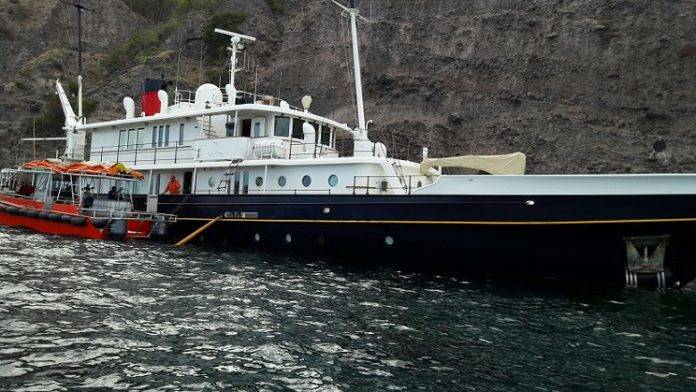SABA — The Saba government is pleased with the verdict of the Rotterdam Court on Wednesday, February 24, 2021. A panel of three judges together formed the maritime chamber of the Rotterdam Court that reviewed the case and concluded to dismiss all claims of Elsa Shipping Limited (Elsa Shipping).
Elsa Shipping took the Public Entity Saba, the Saba Conservation Foundation (SCF) and the Netherlands to court for the stranding and total loss of the ship, the MY Elsa on March 22, 2017. According to Elsa Shipping, the Public Entity Saba, the SCF and the Netherlands were both jointly and severally responsible for the main sums of US $ 7,090,925.63, € 8,361.52, and £ 5,971.72 and legal interest.
According to Elsa Shipping, in summary, the Netherlands was liable because they are the responsible and competent authority for the waterways around the islands Bonaire, Saba and Sint Eustatius. Elsa Shipping claimed the Public Entity Saba was responsible because it was the owner of the mooring that broke, and the SCF was responsible because the park ranger that instructed the crew of Elsa Shipping to use the mooring that broke works for the SCF.
According to Elsa Shipping, the risk and responsibility for moorings that break lies with these three entities jointly because the mooring qualified as a permanent fixture that was constructed in the sea, which in Dutch is also called an ‘opstal’. The qualification of the mooring as a permanent fixture would have the legal consequence that the risk and responsibility was indeed for the defendants, should anything go wrong.
Next to that, Elsa Shipping claimed that the Netherlands was separately responsible because it did not ensure that the mooring was not faulty, nor did tit properly maintain the mooring or offer any guidance with detailed instructions upon use of the mooring. According to Elsa Shipping, the SCF was responsible because it was their park ranger that provided uninformed instructions to the Elsa crew to use that mooring.
All three defendants were jointly represented by the solicitor general of the Netherlands (in Dutch: ‘de landsadvocaat’), Mr. Edward Brans of the firm Pels Rijcken, based in The Hague, the Netherlands, who worked closely together with the local legal counsel of the Public Entity Saba Mr. Gerald Simmons – de Jong. The three defendants jointly requested the judges to dismiss the claims.
According to the defendants the cause of the stranding was not the line that broke off the mooring. They argued that the ship stranded because the captain and crew had turned down the volume of the alarm sound that was supposed to warn them in combination with the fact that there was no apparent crewmember designated with watch duty, which was disastrous, particularly when in open sea conditions over 350 meters away from the shore.
The defendants disputed that the mooring qualified as a permanent fixture, because it has the shape of a big metal anchor and can be moved freely. The Public Entity Saba argued that it could not be blamed, because the mooring had just been commissioned two months before and was only up for its first scheduled check-up later on. The SCF argued that the park ranger did nothing wrong because he just called the captain of the Elsa to ensure that he would not anchor outside of the anchor zones and only confirmed the capacity of the mooring as was confirmed by the company that commissioned it.
Regarding the question whether or not the mooring qualifies as a permanent fixture (in Dutch: ‘opstal’), which then would be accompanied by all of its legal consequences regarding risk and responsibility, the judges considered that it was not a permanent fixture. The main considerations for this were that neither the anchor, nor its chain were permanently anchored into the bottom of the sea by either drilling a hole in the sea bed or by installing a concrete foot. This meant that the mooring did not qualify as a permanent fixture as meant in article 6:174 paragraph 4 of the BES Civil Code, but a loose asset (in Dutch: ‘roerende zaak’) as meant in article 6:173 of the BES Civil Code.
The next main question was whether the mooring indeed was defective and if the defendants were aware of the dangers in using this mooring. According to the judges, Elsa Shipping did not provide substantiated proof that the defendants were aware of this. There was no inconclusive proof that the mooring was faulty and that the defendants were to blame for this. The installation report of the mooring confirmed that it could carry ships over 1,100 ton in normal weather and that it was only installed two months before the stranding. The first scheduled maintenance and inspection was scheduled for April 20 or 21, 2017.
The specialist damage report as commissioned by Cunningham Lindsey Dutch Caribbean also confirmed that the installation itself met the requirements that it should meet, but that it was not installed in the right position. The wrong position had caused it to be located too close to rock formations that in turn caused the line to chafe and eventually break. There was no reason for the Public Entity Saba to doubt the installation documents.
The main advisor of the Public Entity Saba in this case Mr. Gerald Simmons – de Jong said that this verdict was another result made possible by a great collaboration between the different departments in The Hague and the Public Entity Saba. “Both the Ministry of Home Affairs and Kingdom Relations and the Ministry of Infrastructure and Water Management showed great trust and understanding towards the local circumstances on Saba and we really worked well together to present the case as best as we could to the panel of judges,” he said.

































